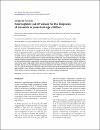Haemoglobin cut-off values for the diagnosis of anaemia in preschool-age children.
| Author | Hamed, Ehab |
| Author | Syed, Mohamed Ahmed |
| Author | Alemrayat, Bayan Faleh |
| Author | Tirmizi, Syed Hammad Anwar |
| Author | Alnuaimi, Ahmed Sameer |
| Available date | 2023-07-31T12:24:52Z |
| Publication Date | 2021-06-15 |
| Publication Name | American Journal of Blood Research |
| Citation | Hamed, E., Syed, M. A., Alemrayat, B. F., Tirmizi, S. H. A., & Alnuaimi, A. S. (2021). Haemoglobin cut-off values for the diagnosis of anaemia in preschool-age children. American Journal of Blood Research, 11(3), 248. |
| ISSN | 2160-1992 |
| Abstract | The World Health Organisation (WHO) suggests haemoglobin that (Hgb) cut-off levels below 2SD from the population mean to initiate anaemia investigations. In the absence of epidemiological data, Hgb less than 11 g/dL is considered abnormal in children up to the age of 59 months (4 years and eleven months). This study reports on the Hgb cut-off levels among children at 1 and 4 years of age. The study compared the prevalence based on the WHO generic cut-off levels and population-specific cut-off-based value defined as below 2SD from the population mean. A cross-sectional record-based study of healthy children below the age of 59 months attending primary care settings in Qatar. 3 years of Hgb data were collected and analysed using descriptive analyses. We excluded children with any pre-existing disease or who have altered biological parameters indicating a non-healthy child. 39407 Participants were stratified into different sub-groups according to age, gender, and ethnicity. Hgb levels were expressed as the mean ± 2SD for children of one and four years of age. Most children were from Western Asia (45.6%), followed by Northern Africa (23.7%), and Southern Asia (21.7%). Our findings for one-year-old children cut-off levels for anaemia might be as low as 9.9 g/dL and 10.6 g/dL for 4-years old. Hgb cut-off values may be set at higher levels for one-year and four-year age groups and many different ethnicities. Higher cut-off points may overestimate the problem as a public health issue. Children may be unnecessarily treated with iron or have needless investigations. |
| Language | en |
| Publisher | e-Century Publishing |
| Subject | Cut-off levels anaemia children diagnosis paediatric |
| Type | Article |
| Pagination | 248–254 |
| Issue Number | 3 |
| Volume Number | 11 |
Files in this item
This item appears in the following Collection(s)
-
Medicine Research [1549 items ]


